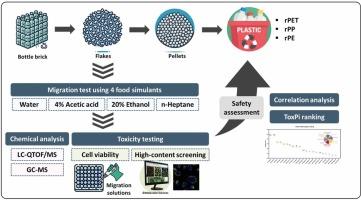Toxicity evaluation and prioritization of recycled plastic food contact materials using in silico tools
IF 12.2
1区 环境科学与生态学
Q1 ENGINEERING, ENVIRONMENTAL
引用次数: 0
Abstract
This study assessed the toxicity of virgin and recycled plastic food contact materials (FCMs) at various recycling stages, migrated in four food simulants (water, 20% ethanol, 4% acetic acid, and n-heptane), using cytotoxicity and high-content screening (HCS) bioassays. Toxicity was correlated with migrating substances identified through chemical analyses, and samples were ranked by toxicity priority. Recycled polyethylene terephthalate (rPET) and 20% ethanol exhibited the highest reduction in cell viability, whereas virgin PET (vPET) showed even lower viability. Pellets did not trigger oxidative responses in HepaRG and HK-2 cells; however, bales and flakes affected their cell morphology and mitochondrial function. rPET-flake migration in 4% acetic acid was most toxic to HepaRG cells, while rPET-bale migration in 20% ethanol and rPP-flake migration in water were most toxic to HK-2 cells. Nonetheless, the negative effects on cell viability and HCS parameters were mostly mitigated at the final pellet stage. In HepaRG cells exposed to 4% acetic acid, antimony negatively correlated with cell viability and positively with cellular area, indicating its role in rPET-induced necrosis. ToxPi ranking identified vPET migration in n-heptane and water as top priorities given the nephrotoxic risks. This study emphasizes refining recycling methods and testing plastics to minimize FCM cytotoxicity.

求助全文
约1分钟内获得全文
求助全文
来源期刊

Journal of Hazardous Materials
工程技术-工程:环境
CiteScore
25.40
自引率
5.90%
发文量
3059
审稿时长
58 days
期刊介绍:
The Journal of Hazardous Materials serves as a global platform for promoting cutting-edge research in the field of Environmental Science and Engineering. Our publication features a wide range of articles, including full-length research papers, review articles, and perspectives, with the aim of enhancing our understanding of the dangers and risks associated with various materials concerning public health and the environment. It is important to note that the term "environmental contaminants" refers specifically to substances that pose hazardous effects through contamination, while excluding those that do not have such impacts on the environment or human health. Moreover, we emphasize the distinction between wastes and hazardous materials in order to provide further clarity on the scope of the journal. We have a keen interest in exploring specific compounds and microbial agents that have adverse effects on the environment.
 求助内容:
求助内容: 应助结果提醒方式:
应助结果提醒方式:


